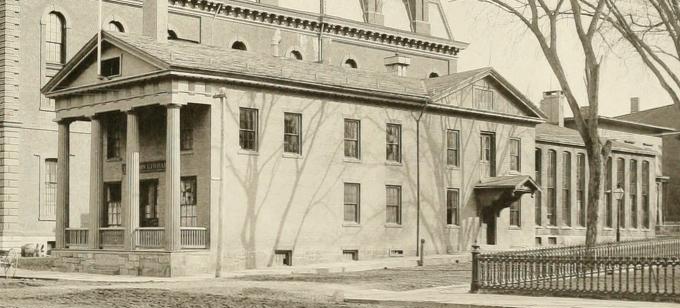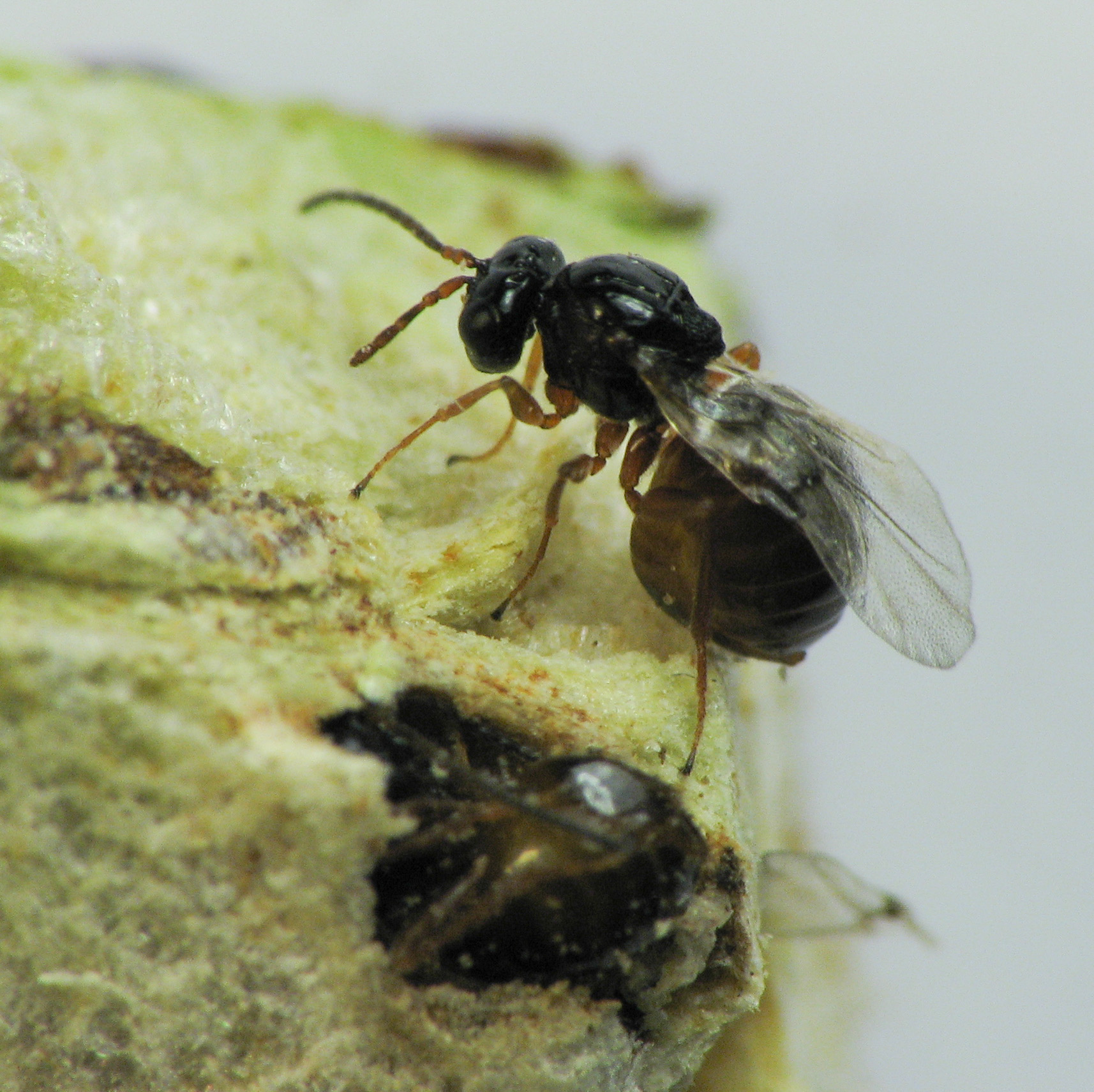|
Feron Kingi
''Feron kingi'', the red cone gall wasp, is a species of gall wasp in the family Cynipidae. This species induces galls on various white oak species, such as the valley oak ''Quercus lobata''. The galls housing the Parthenogenesis, parthenogenetic females are detachable red cones measuring about 5 mm tall. These form on either side of the leaves, often with many forming per leaf. Adults emerge in winter from the tip of the cone. References External links * ''Feron kingi'' on gallformers Cynipidae Articles created by Qbugbot Insects described in 1900 Oak galls Gall-inducing insects Taxa named by Homer Franklin Bassett {{apocrita-stub ... [...More Info...] [...Related Items...] OR: [Wikipedia] [Google] [Baidu] |
Homer Franklin Bassett
Homer Franklin Bassett (September 2, 1826 – June 28, 1902) was an American hymenoptera, hymenopterist specializing in gall wasps. In addition, he was the librarian of Silas Bronson Library in Waterbury, Connecticut. Early life and education Bassett was born on September 2, 1826, in the town of Florida, Massachusetts. His parents were Ezra and Keziah (née Witt) Bassett. In 1836 he and his father moved to Rockport, Ohio. He enrolled in Oberlin College in 1847, but due to poor health he had to leave the following year. He returned to New England in 1849. Work as librarian Bassett worked at the Silas Bronson Library in Waterbury, Connecticut for nearly thirty years. He started work on September 1, 1872, after the resignation of W. I. Fletcher, its first librarian. The number of volumes in the library more than quadrupled in his first five years. Bassett also made a card catalog of the collection's 2,800 pamphlets. He also was the librarian during the move to a new building i ... [...More Info...] [...Related Items...] OR: [Wikipedia] [Google] [Baidu] |
Gall Wasp
Gall wasps, also traditionally called gallflies, are hymenopterans of the family Cynipidae in the wasp superfamily Cynipoidea. Their common name comes from the galls they induce on plants for larval development. About 1,300 species of this generally very small creature () are known worldwide, with about 360 species of 36 different genera in Europe and some 800 species in North America. Features Like all Apocrita, gall wasps have a distinctive body shape, the so-called wasp waist. The first abdominal tergum (the propodeum) is conjoined with the thorax, while the second abdominal segment forms a sort of shaft, the petiole. The petiole connects with the gaster, which is the functional abdomen in apocritan wasps, starting with the third abdominal segment proper. Together, the petiole and the gaster form the metasoma, while the thorax and the propodeum make up the mesosoma. The antennae are straight and consist of two or three segments. In many varieties, the backside of the ... [...More Info...] [...Related Items...] OR: [Wikipedia] [Google] [Baidu] |
Cynipidae
Gall wasps, also wikt:gallfly#Usage notes, traditionally called gallflies, are hymenopterans of the family Cynipidae in the wasp superfamily Cynipoidea. Their common name comes from the galls they induce on plants for larval development. About 1,300 species of this generally very small creature () are known worldwide, with about 360 species of 36 different genera in Europe and some 800 species in North America. Features Like all Apocrita, gall wasps have a distinctive body shape, the so-called Petiole (insect anatomy), wasp waist. The first abdominal tergum (the propodeum) is conjoined with the Thorax (insect anatomy), thorax, while the second abdominal segment forms a sort of shaft, the Petiole (insect anatomy), petiole. The petiole connects with the gaster (insect anatomy), gaster, which is the functional abdomen in apocritan wasps, starting with the third abdominal segment proper. Together, the petiole and the gaster form the metasoma, while the thorax and the propodeum mak ... [...More Info...] [...Related Items...] OR: [Wikipedia] [Google] [Baidu] |
White Oak
''Quercus'' subgenus ''Quercus'' is one of the two subgenera into which the genus ''Quercus'' was divided in a 2017 classification (the other being subgenus ''Cerris''). It contains about 190 species divided among five sections. It may be called the New World clade or the high-latitude clade; most species are native to the Americas, the others being found in Eurasia and northernmost North Africa. Description Members of subgenus ''Quercus'' are distinguished from members of subgenus ''Cerris'' by few morphological features, their separation being largely determined by molecular phylogenetic evidence. All are trees or shrubs bearing acorn-like fruit in which a cup covers at least the base of the nut. The outer structure of the mature pollen is one feature that distinguishes the two subgenera: in subgenus ''Quercus'', the small folds or wrinkles (rugulae) are obscured by sporopollenin, whereas in subgenus ''Cerris'', the rugulae are visible or at most weakly obscured. The two sub ... [...More Info...] [...Related Items...] OR: [Wikipedia] [Google] [Baidu] |
Quercus Lobata
''Quercus lobata'', commonly called the valley oak or roble, is the largest of the California oaks. It is endemic to the state, growing in interior valleys and foothills from Siskiyou to San Diego counties. Deciduous, it requires year-round groundwater, and may live up to 600 years. Its thick, ridged bark (resembling alligator hide) and deeply lobed leaves are characteristic, and assist in identification. Description The valley oak may surpass in height, with a sturdy trunk possibly exceeding in diameter. The "Henley Oak", in Covelo, California, is the tallest known valley oak, at . The branches have an irregular, spreading and arching appearance. During autumn, the leaves turn a yellow to light orange color but become brown later in the season. In advancing age, the branches droop. The trees have pewter-colored rippled bark. Typically, the leaves are long and are roundly and deeply lobed. The leaf width is approximately one half its length. Each leaf is matte green with an ... [...More Info...] [...Related Items...] OR: [Wikipedia] [Google] [Baidu] |
Parthenogenesis
Parthenogenesis (; from the Greek + ) is a natural form of asexual reproduction in which the embryo develops directly from an egg without need for fertilization. In animals, parthenogenesis means the development of an embryo from an unfertilized Gametophyte, egg cell. In plants, parthenogenesis is a component process of apomixis. In algae, parthenogenesis can mean the development of an embryo from either an individual sperm or an individual egg. Parthenogenesis occurs naturally in some plants, algae, invertebrate animal species (including nematodes, some tardigrades, water fleas, some scorpions, aphids, some mites, some bees, some Phasmatodea, and parasitic wasps), and a few vertebrates, such as some fish, amphibians, and reptiles. This type of reproduction has been induced artificially in animal species that naturally reproduce through sex, including fish, amphibians, and mice. Normal egg cells form in the process of meiosis and are haploid, with half as many chromosomes as t ... [...More Info...] [...Related Items...] OR: [Wikipedia] [Google] [Baidu] |
Princeton University Press
Princeton University Press is an independent publisher with close connections to Princeton University. Its mission is to disseminate scholarship within academia and society at large. The press was founded by Whitney Darrow, with the financial support of Charles Scribner, as a printing press to serve the Princeton community in 1905. Its distinctive building was constructed in 1911 on William Street in Princeton. Its first book was a new 1912 edition of John Witherspoon's ''Lectures on Moral Philosophy.'' History Princeton University Press was founded in 1905 by a recent Princeton graduate, Whitney Darrow, with financial support from another Princetonian, Charles Scribner II. Darrow and Scribner purchased the equipment and assumed the operations of two already existing local publishers, that of the ''Princeton Alumni Weekly'' and the Princeton Press. The new press printed both local newspapers, university documents, '' The Daily Princetonian'', and later added book publishing ... [...More Info...] [...Related Items...] OR: [Wikipedia] [Google] [Baidu] |
Articles Created By Qbugbot
Article often refers to: * Article (grammar) In grammar, an article is any member of a class of dedicated words that are used with noun phrases to mark the identifiability of the referents of the noun phrases. The category of articles constitutes a part of speech. In English language, Engl ..., a grammatical element used to indicate definiteness or indefiniteness * Article (publishing), a piece of nonfictional prose that is an independent part of a publication Article(s) may also refer to: Government and law * Elements of treaties of the European Union * Articles of association, the regulations governing a company, used in India, the UK and other countries; called articles of incorporation in the US * Articles of clerkship, the contract accepted to become an articled clerk * Articles of Confederation, the predecessor to the current United States Constitution * Article of impeachment, a formal document and charge used for impeachment in the United States * Article of m ... [...More Info...] [...Related Items...] OR: [Wikipedia] [Google] [Baidu] |
Insects Described In 1900
Insects (from Latin ') are hexapod invertebrates of the class Insecta. They are the largest group within the arthropod phylum. Insects have a chitinous exoskeleton, a three-part body (head, thorax and abdomen), three pairs of jointed legs, compound eyes, and a pair of antennae. Insects are the most diverse group of animals, with more than a million described species; they represent more than half of all animal species. The insect nervous system consists of a brain and a ventral nerve cord. Most insects reproduce by laying eggs. Insects breathe air through a system of paired openings along their sides, connected to small tubes that take air directly to the tissues. The blood therefore does not carry oxygen; it is only partly contained in vessels, and some circulates in an open hemocoel. Insect vision is mainly through their compound eyes, with additional small ocelli. Many insects can hear, using tympanal organs, which may be on the legs or other parts of the body. The ... [...More Info...] [...Related Items...] OR: [Wikipedia] [Google] [Baidu] |
Oak Galls
An oak apple or oak gall is a large, round, vaguely apple-like gall commonly found on many species of oak. Oak apples range in size from in diameter and are caused by chemicals injected by the larva of certain kinds of gall wasp in the family Cynipidae. Formation The adult female wasp lays single eggs in developing leaf buds. The wasp larvae feed on the gall Tissue (biology), tissue resulting from their secretions, which modify the oak bud into the gall, a structure that protects the developing larvae until they undergo metamorphosis into adults. Some common oak-apple-forming species are the ''Biorhiza pallida'' gall wasp in Europe, ''Amphibolips confluenta'' in eastern North America, and ''Atrusca bella'' in western North America. Oak apples may be brownish, yellowish, greenish, pinkish, or reddish. Other galls Considerable confusion exists in the general literature between the oak apple and the Andricus kollari, oak marble gall. The oak marble is frequently called the o ... [...More Info...] [...Related Items...] OR: [Wikipedia] [Google] [Baidu] |






